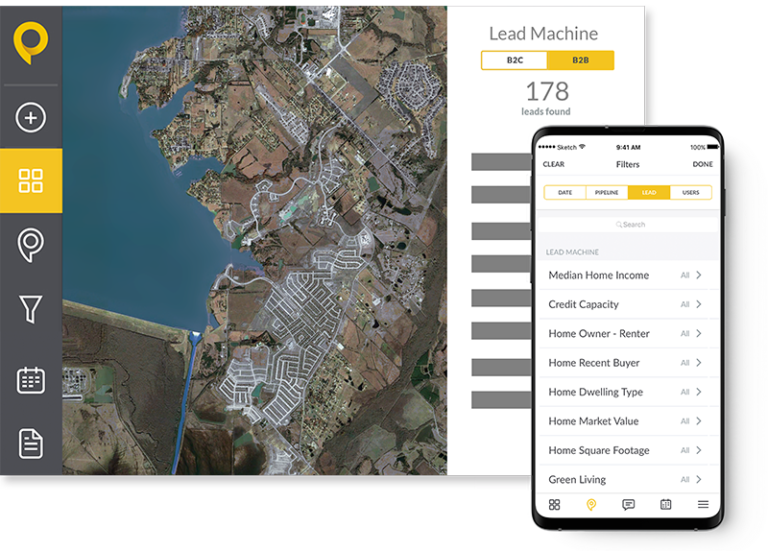Why do 84% of sales reps miss their annual quotas? The answer isn’t lack of effort: it’s lack of strategy. Territory overlap, inefficient prospecting, and zero accountability create revenue leaks that drain even the most motivated teams.
A sales action plan serves as the blueprint for transforming scattered activities into systematic success. This comprehensive framework outlines sales objectives, strategies, and tactics that your entire sales team can execute with confidence. More importantly, it identifies potential obstacles before they derail your progress.
Ready to build a quota-crushing machine? Here’s your 10-step roadmap to field sales dominance.
What is a Sales Action Plan?
A sales action plan highlights what you’re going to do to achieve your sales goals, focusing specifically on the transactions and relationships that you can cultivate with customers.
Sales plans contain information about who you want to sell to, what your revenue goals look like, and how you’re going to structure your teams for success.
An effective sales management plan:
- Communicates your sales objectives and goals
- Outlines responsibilities and roles for both your staff and leadership
- Delivers strategic direction for your sales team
- Guides your decision-making strategy to help you progress towards organizational goals
While a sales action plan is excellent for month-to-month guidance, it can also help you conduct a more long-term analysis of your sales pipeline and sales team. Over time, you can compare your action plans against your outcomes to see if you’re achieving your targets.
Overview of the 10-Step Sales Action Plan
Transform scattered field activities into systematic success with this proven framework:
- Identify Your Ideal Customers – Build data-driven customer profiles
- Assess Historical Performance – Learn from wins and losses
- Chart Your Destination – Set SMART revenue goals
- Put Resources in Place – Deploy mobile-first field sales tools
- Invest in Continuous Training and Skill Development – make time for ongoing education
- Prospect with ICP Data – Apply territory intelligence strategically
- Assign Territories – Eliminate costly overlap
- Develop Scripts for Face-to-Face Conversation Mastery – Master in-person interactions
- Set Minimum Daily Sales Activities – Define measurable field metrics
- Enforce Accountability Through Performance Tracking – Monitor and optimize results
Ready to implement? Watch our video overview, then scroll down for a comprehensive guide to executing each step effectively.
10-Step Action Plan to Reach Short and Long Term Sales Targets
A sales action plan needs to give your team members direction and purpose. It should ensure that your staff have everything they need to achieve their goals when it comes to things like quotas and prospecting. The more detailed your plan is, the less likely it is that your team will end up confused and struggling to make decisions for themselves.
1. Identify Your Ideal Clients
To achieve success with your sales strategy, start by creating a comprehensive Ideal Customer Profile (ICP) based on your existing customer data. This foundational step determines everything else in your sales action plan.
Analyze Your Best Customers: Review your last 10-20 closed deals and identify patterns among your most valuable accounts. Ask your sales team:
- Which customers deliver the most long-term value from our products?
- Who bought the fastest without haggling on price?
- For B2B sales, what company size, industry, and revenue ranges consistently convert?
- How did these customers originally discover our products/solution (i.e. cold calls, canvassing, word of mouth)?
Define Key ICP Attributes: Create a ranked list of 5-7 primary characteristics that define your ideal accounts. Focus on firmographics (company size, industry, location), technographics (current tech stack), and behavioral indicators (growth stage, buying patterns).
Document Pain Points and Use Cases: Understand the specific problems your solution solves for these ideal customers. What challenges drive them to seek your product? What outcomes do they achieve?
Create Your ICP Reference Guide: Develop a one-page document that includes demographics, firmographics, pain points, key objectives, and sample customer logos. This becomes your team’s north star for all prospecting activities.
Field Sales Reality Check: Face-to-face interactions give you advantages that inside sales teams can’t match. Your prospects will see your value proposition in person, which is crucial for complex solutions requiring demonstration.
2. Assess Historical Performance
Unless you’re a brand-new business, you should have some room to learn from your past mistakes and successes. Look back over your previous wins and losses and ask yourself:
- Which strategies led to the most revenue for your company?
- What kind of customers were most likely to respond to your sales pitch?
- Were there certain months or seasons where you were more likely to reach your quota?
- Which of your team members were most successful, and why?
- Which areas delivered the most ROI for your team?
Territory-Specific Analysis: Field sales performance varies dramatically by geography, season, and local market conditions. Examine not just what worked, but where and when it worked best.
Examining your historical performance will help you to get a better idea of where your current customers and prospects come from.
Sales tracking software can give you a more complete history of this information. Examine not just when and where inbound and outbound leads convert, but also how your teams prospected with these clients, and which tactics were most successful.
| Bonus resource: 8 Compelling Reasons to Invest in a Sales Activity Tracker |
3. Chart your Destination: Set SMART Revenue Goals
Successful field sales teams reverse-engineer success by setting specific, measurable targets that cascade from annual objectives down to daily activity metrics. Without clear destination markers, even the most motivated sales reps struggle to prioritize their time and energy effectively.
The key to effective goal setting lies in creating a logical hierarchy where each level supports the next, ensuring every daily action contributes to your ultimate revenue objectives.
For example:
- Annual Revenue Targets: If your team closed $2M last year, target $2.4M this year (20% growth). Base increases on historical performance plus realistic market expansion opportunities.
- Quarterly Milestones: Break annual goals into 90-day sprints. Q1 might focus on territory optimization, Q2 on new prospect acquisition, Q3 on pipeline acceleration, Q4 on deal closure.
- Monthly Activity Goals: Connect revenue targets to specific activities. If you need 24 new deals annually, that’s 2 per month, which might require 40 qualified prospects, demanding 200 initial contacts.
- Daily Activity Goals: Transform monthly targets into manageable daily actions that your reps can execute consistently. Using the example above, 200 monthly contacts equals 10 prospect touches per day (assuming 20 working days). This might break down to 5 cold calls, 3 follow-up visits, and 2 referral conversations daily. These activity-based metrics become the foundation for accountability and performance tracking.
This cascading approach to SMART goals ensures that every outbound call contributes to monthly contact goals, which drive quarterly milestones, ultimately delivering annual revenue growth.
When your big picture goal is generating more closed sales, the path becomes clear: more strategic daily activities create more opportunities, which compound into quota-crushing results.
4. Choose Mobile-First Field Sales Resources
Field sales reps work offline, in vehicles, and face-to-face with prospects. Your technology stack must reflect this reality.
Essential Field Sales Resources:
- CRM tools: Mobile-first platforms that sync offline data and provide real-time territory insights. Your teams need to track interactions with crucial clients and customers while maintaining full functionality without internet connectivity.
- Prospecting tools: Territory-specific lead generation that identifies prospects within driving distance. Field reps need tools that understand geographic constraints and local market dynamics.
- Route Optimization: Minimize windshield time, maximize face time. Smart routing can increase daily prospect meetings by 30-40%.
- Commission Structure: Build compensation plans that reward both activity and results. Consider territory-specific bonuses for market penetration and customer retention.
Once you know which tools your employees need, make sure that your team members are well-equipped to use them. This could mean implementing training sessions, assigning mentors to new team members, or holding one-on-one meetings to discuss their sales plan.
5. Invest in Continuous Training and Skill Development
Field sales reps work independently, making continuous skill development critical for sustained success. Unlike inside sales teams with constant supervision, field reps must master advanced sales techniques and adapt to diverse prospect environments.
Essential Training Components:
Product Knowledge Updates: Quarterly deep-dives on new features, competitive positioning, and industry applications. Field reps need to answer complex questions on-site without support.
- Advanced Sales Techniques: Negotiation mastery, objection handling, and consultative selling approaches specific to face-to-face interactions. Role-playing exercises should simulate real field scenarios.
- CRM and Lead Generation Tool Training: Mobile platform proficiency, offline data management, and territory optimization strategies. Field reps must maximize technology while maintaining personal connection.
- Sales Automation Training: Sequence management, follow-up automation, and pipeline velocity tools that work seamlessly with field activities.
- Mentorship Program: Pair new reps with top performers for territory shadowing, joint sales calls, and ongoing coaching. Field sales success transfers through observation and practice.
- Regular Skill Assessments: Monthly evaluations of presentation skills, objection handling, and closing techniques. Provide immediate feedback and targeted improvement plans.
- Certification Opportunities: Industry-specific credentials that enhance credibility with prospects and demonstrate ongoing professional development.
The ROI from sales rep training is over 300%, making this investment essential for quota achievement. Plus, investing in your team has numerous other benefits, from enhanced communication skills and increased confidence to improved employee retention and stronger customer relationships.
6. Prospect with ICP data
In step 1, you defined your ideal customer profile. Now it’s time to use that data strategically to find and engage high-value prospects within your territories.
Territory-Specific Qualification: Use your ICP criteria to pre-qualify prospects before investing travel time. Focus on clusters of qualified prospects to maximize daily face-to-face meetings while minimizing drive time between appointments.
Leverage Advanced Prospecting Tools: Field sales reps can use platforms like the SPOTIO Lead Machine to identify potential prospects matching your ICP, then apply 200+ data attributes—age, business type, revenue, credit capacity—to pre-qualify the best opportunities within specific sales territories.
Smart Prospecting Workflow:
- Filter by Geography: Identify ICP-matching companies within your territory boundaries
- Layer in Behavioral Triggers: Look for signals like recent funding, new hires, or technology changes that indicate buying readiness
- Prioritize by Fit Score: Rank prospects based on how closely they match your ICP attributes
- Plan Efficient Routes: Group qualified prospects geographically to optimize daily scheduling
Multi-Channel Engagement Strategy: Once you’ve identified qualified prospects, determine the best approach for each. Some may respond to cold door knocks, others to warm introductions through LinkedIn, and others to referrals from existing customers.
Continuous ICP Refinement: Use prospecting results to refine your ICP quarterly. Which attributes consistently predict successful conversions? Which criteria need adjustment based on territory-specific market conditions?
This approach ensures every prospecting hour generates maximum ROI by focusing exclusively on accounts that match your proven success patterns.

7. Assign Territories Strategically
Now it’s time to make sure that there’s limited overlap in your teams. It’s hard to reach your goals when everyone is focused on selling to the same area.
Assigning territories ensures that your sales team is targeting the right customers, in the right areas, and ultimately eliminates costly redundancies.
Territory Assignment Strategies:
- Top Performers: Assign highest-value accounts and largest territories
- Skill Alignment: Match salespeople to segments best-suited to their talents
- Lead Capacity: Ensure all reps have adequate prospects to work
- Relationship Continuity: Maintain existing customer relationships during transitions
Clearly defined territories help sales teams work more strategically to address the needs and expectations of their clients. You can assign territories by geography, customer type, sales potential, and industry.
8. Develop Scripts for Face-to-Face Conversation Mastery
Effective field sales scripts focus on addressing customer pain points while leveraging the emotional nature of buying decisions. People buy emotionally and justify rationally, making face-to-face interactions particularly powerful for building trust and connection.
Structure your conversations using the 70:30 rule—prospects should talk 70% of the time while your reps listen actively and guide strategically. This approach uncovers pain points, qualifies opportunities, and positions your solution as the logical choice.
Essential Scripts for Field Teams
Now that you understand field sales advantages, let’s explore specific script frameworks your team can implement immediately:
- Cold Door Knocks: Opening statements that quickly establish credibility and value proposition. “I’m working with three other [industry] companies in this area who’ve increased [specific metric] by [percentage]. Mind if I show you how?”
- Follow-Up Visits: Conversation starters that reference previous interactions and demonstrate ongoing value. “Last time we talked, you mentioned [specific challenge]. I’ve got some ideas that might help.”
- Reading the Room: Train reps to adjust their approach based on prospect engagement levels. Scripts should include environmental cues and body language indicators that signal when to pivot, probe deeper, or advance the conversation.
- Objection Handling for Face-to-Face: Address common field sales objections like “I need to think about it” or “I have to talk to my partner” with responses that leverage in-person advantages. Use the opportunity to schedule immediate follow-up meetings or provide additional materials on the spot.
Implementation and Practice Recommendations
These script frameworks translate into immediate results when your team practices and adapts them consistently. Ensure scripts are available on mobile devices for quick reference between meetings, but emphasize natural conversation flow over rigid adherence. Role-play exercises should simulate real field scenarios, helping reps master the balance between structure and spontaneity that makes face-to-face selling so effective.
Remember that scripts serve as conversation guides, not word-for-word recitations. The goal is confident, consultative dialogue that uncovers opportunities for bigger upsells and cross-sells while building lasting customer relationships.
9. Set Minimum Daily Sales Activities
With support and guidance, your sales teams should have everything they need to accomplish real, measurable goals within your sales strategy. Set realistic but challenging daily activities that drive pipeline growth.
Essential Daily Activity Metrics:
- New Prospects: Target 5-10 new qualified leads per day through territory canvassing, referrals, and lead generation tools. The SPOTIO Lead Machine can help agents find fresh prospects daily.
- Face-to-Face Contacts: Aim for 8-12 in-person interactions daily, including cold calls, scheduled appointments, and follow-up visits. Field sales success depends on relationship building through personal connection.
- Follow-up Activities: Complete 15-20 follow-up touches across multiple channels—phone calls, emails, text messages, and social media connections. Use a tool like SPOTIO AutoPlays to sequence critical sales activities
- Referral requests: Ask for 2-3 referrals daily from satisfied customers, prospects, and business partners. Face-to-face requests generate 5x more referrals than phone or email.
- Pipeline Updates: Maintain real-time CRM data with detailed notes from each interaction, next steps, and opportunity progression.
Although it’s valuable to challenge employees, be realistic about their sales plan. Asking staff to accomplish more than they’re reasonably capable of could lead to disengagement. And this brings us to the next step: enforcing accountability.
10. Enforce Accountability Through Performance Tracking
Once you’ve defined daily expectations, tracking becomes essential for maintaining momentum and identifying improvement opportunities.
- Daily Activity Monitoring: Track calls, visits, demos scheduled, and pipeline progression. Field teams need immediate feedback on activity completion and quality metrics.
- Weekly Pipeline Reviews: Analyze territory performance, deal progression, and forecast accuracy. Identify bottlenecks before they impact quarterly results.
- Territory Analysis: Compare performance across geographic areas, identifying high-potential zones and optimization opportunities.
- Competitive Elements: Implement leaderboards, team challenges, and recognition programs that celebrate both activity and results. Field sales reps respond well to public recognition and friendly competition.
- Continuous Improvement Cycle: Track performance data, analyze patterns, adjust strategies, and repeat. Use insights to refine territory assignments, script effectiveness, and training priorities.
SPOTIO’s My Reports feature makes it quick and easy for sales admins, managers and reps to generate custom reports containing only the most important metrics. Sales reports can be customized, saved as a reusable template, and accessed from any device while on-the-go. This ensures everyone in the company has access to the insights they need to confidently allocate resources and hit quota.
Finally, track performance at multiple levels:
- Individual Rep: Activity completion, conversion rates, quota attainment
- Territory: Market penetration, customer retention, competitive wins
- Team: Overall quota achievement, pipeline health, forecast accuracy
By tracking performance at every level, you can uncover top-performing reps, identify training needs, and pinpoint which sales strategies drive bottom-line results
The Meetings, Pitches and Deals Should Follow
Your sales action plan is all about giving your sales team the guidance that they need to make smart business decisions. When you can support sales team members by addressing issues that are within your direct control, such as a lack of guidance and direction, you can improve results dramatically.
If your sales strategy works for reps and ensures they have everything that needed to follow each step correctly, then reaching targets becomes a lot easier. You’ll find that the meetings, demos, and closed deals will follow naturally.
A successful sales action plan is all about focusing on the proactive actions that your business can invest in, then letting the process develop organically. Don’t hesitate to accept feedback from your employees, while examining quantitative data in your sales activity tracker.
Your employees might offer some insights into the steps they need to take to improve their chances of closing deals and achieving better outcomes.
Ready to Take Action?
There’s no one-size-fits-all strategy to delivering excellent sales numbers and outcomes. The key to success is to figure out what works for your team by examining your processes, employees, and customers.
Designing a sales action plan will help to guide your employees towards more successful results, while making sure that they have the guidance needed to thrive.




